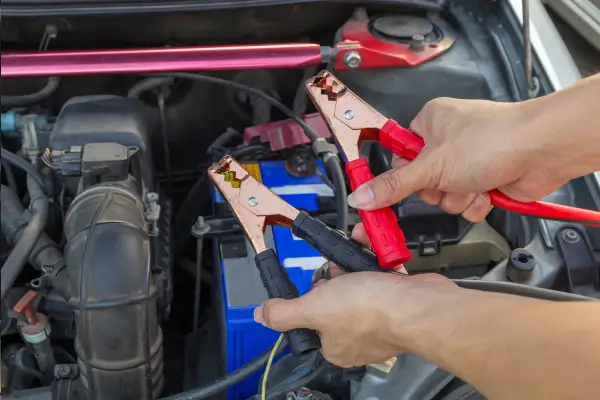It’s frustrating and inconvenient when your car battery dies unexpectedly. But you can quickly get back on the road with the proper knowledge and tools without paying for towing or waiting for roadside assistance. An emergency battery jump starter can save the day. But the question is how to use a battery jump starter.
First, locate the positive and negative terminals on your car’s battery and the jump starter. Ensure they are clean and free from corrosion. Then, connect the red cable to the positive terminal of your car’s battery and the jump starter. Next, connect the black cable to the negative terminal of the jump starter and a metal surface on your car’s engine block, away from the battery. Once connected, turn on the jump starter and start your car. Once your car is running, disconnect the cables in reverse order.
This article teaches you how to use a battery jump starter properly and effectively. With this article, you’ll learn everything you need about jump starters, connecting them to your car’s battery, and troubleshooting common problems.
Preparations before jumpstarting
Before jumpstarting your vehicle with a battery jump starter, it’s crucial to prepare for a safe and successful process.
- Firstly, you should locate your vehicle’s battery, typically found under the hood on either the left or right side, referring to the manual for precise instructions.
- Secondly, ensure all electrical components like headlights, radio, air conditioning, and interior lights are turned off to prevent further battery drain or power surges during jump-starting. Additionally, engage the emergency brake, especially if parked on an incline, to prevent any potential rolling.
- Lastly, pop the hood using the release lever and secure it with either the prop rod or hood latch to keep it open while you work on jump-starting the vehicle.
How to use a battery jump starter? 7 Easy and Simple Steps
Now that your vehicle is prepared, it’s time to connect the battery jump starter and provide the necessary power to jump-start your vehicle’s battery. Follow these steps to ensure a secure and effective connection:

Step#01 Locate Terminals
Identify the positive (+) and negative (-) terminals on your vehicle’s battery and the jump starter. The positive terminal is typically marked with a “+” symbol and may be red, while the negative terminal is marked with a “-” symbol and maybe black.
Step#02 Attach the Positive Clamp
Take the positive clamp from the battery jump starter and securely attach it to the positive terminal of your vehicle’s battery. Ensure the connection is tight and the clamp is fully seated on the terminal.
Step#03 Connect the Negative Clamp.
Take the negative clamp from the battery jump starter and connect it to an unpainted metal surface within the engine compartment. Look for a sturdy metal bracket or unpainted bolt near the engine, away from moving parts and the battery.
This step helps prevent potential sparks near the battery, ensuring safety during the jump-starting process.
Step#03 Ensure a Secure Connection
Double-check that both clamps are securely attached and not loose.
Wiggle them slightly to ensure they are correctly gripping the terminals and metal surfaces.
Step#04 Activate the Jump Starter.
Refer to the instructions provided with your battery jump starter to activate the power supply.
This typically involves turning on the power switch or pressing a designated button.
Step#05 Charge the Battery
Once activated, give the jump starter a few moments to transfer power to your vehicle’s battery. This allows the battery to receive a sufficient charge before starting the engine.
Step#06 Start the Vehicle
With the jump starter connected and charged, turn the ignition key or press the start button to crank the engine. If the jump start is successful, your vehicle should start up smoothly.
Step#07 Remove the Clamps in Reverse Order
Once your vehicle has started, removing the clamps in the correct order is essential.
Start by removing the negative clamp from the unpainted metal surface in the engine compartment. Next, remove the positive clamp from your vehicle’s battery terminal.
Read more about who to call for a jump starter?
Safety Precautions while jump-starting your battery
Before knowing how to use a battery jump starter, safety should always be the top priority when dealing with batteries and jump-starting a vehicle. Safety precautions are essential when you use a battery jump starter. Here are a few safety tips:
Gear Up
Before attempting to jump-start your vehicle, it’s essential to gear up with the proper safety equipment. By taking these precautions, you can protect yourself and ensure a safer jump-starting process.
Safety goggles or glasses: Put on a pair of safety goggles or glasses to shield your eyes from potential sparks or debris. This simple step can go a long way in preventing eye injuries during the jump-starting procedure.
Gloves: Wearing insulated gloves is essential for your safety. These gloves protect your hands from electrical shocks and provide a better grip on the cables. They ensure you can confidently handle the jump-starting process and reduce risk.
Create a Safe Environment

Creating a safe environment is essential before you start the jump-starting process. Following these guidelines can minimize potential risks and ensure a secure experience.
Park in a well-ventilated area: Choose a space, preferably outdoors, to perform the jump start. This helps prevent the accumulation of potentially explosive gases emitted by the battery during the process. Adequate ventilation is crucial for your safety.
Turn off all electrical devices: Before connecting the jump starter, ensure the vehicle’s ignition is completely turned off, and all electrical devices are switched off. This step helps prevent electrical shorts or surges, reducing the risk of accidents or damage to the jump starter or your vehicle’s electrical system.
Keep bystanders at a safe distance: Clear the area around your vehicle and ensure that bystanders, including children and pets, are at a safe distance. This reduces the risk of accidents or injuries caused by accidental contact with moving parts or electrical components during the jump-start process.
Examine the Battery and Cables
Before connecting the battery jump starter, it’s essential to thoroughly examine the battery and cables to ensure their safety and proper functioning. Following these steps, you can identify potential issues and take appropriate measures.
Check for leaks or cracks in the battery: Inspect the battery for any leaks or cracks. If you notice any signs of damage, such as fluid leaks or visible cracks, do not attempt to jump-start the vehicle yourself.
Seek professional assistance to address the issue. A damaged battery can release harmful gases or even lead to an explosion, so it’s crucial to prioritize your safety.
Inspect the battery terminals and cable connections: Ensure the battery terminals are clean, corrosion-free, and tightly connected. Corrosion can impede the flow of electricity and affect the jump-starting process.
If you notice corrosion on the terminals, you can clean them using a battery terminal cleaner or a mixture of baking soda and water. Make sure to wear gloves and eye protection during this process.
Read the Vehicle Manual
Consult your vehicle’s manual for any specific instructions or precautions related to jump-starting. Some vehicles may have unique procedures, and it’s essential to be aware of them before starting the process.
Pro-Tips for jump starting a battery
After learning how to use a battery jump starter, you should follow some other tips, which are given below:
Tip#01 Maintain a Charged Jump Starter
To ensure the jump starter is ready when needed, make it a habit to check and maintain its charge periodically. Most jump starters have indicators that display the battery level. Recharge the jump starter as needed and follow the manufacturer’s recommendations for proper maintenance.
Tip#02 Practice Proper Cable Handling
When handling the jump starter cables, ensure they are free from any tangles or knots that could interfere with their functionality. Additionally, avoid placing the cables near moving parts of the engine or hot surfaces that could cause damage or safety hazards.
Tip#03 Use a High-Quality Jump Starter
Invest in a reputable, reliable jump starter from a trusted brand. A high-quality jump starter is more likely to perform well and is built with better safety mechanisms and durability.
Tip#04Seek Professional Help if Needed
If you encounter a situation where jump-starting the vehicle doesn’t resolve the issue, there may be other underlying problems with the battery or electrical system. In such cases, it is advisable to consult a professional mechanic or call for roadside assistance to avoid potential damage or risk.
Read more aboutcan you use a jump starter when plugged in?
What are the common problems with battery jump starters
Using a battery to jump-start has some common problems. For these common problems, here are some solutions:
Weak Connection
One common problem with battery jump starters is a weak connection. Sometimes, when trying to jump-start a vehicle, the clamps may not establish a secure connection with the battery terminals.
This can lead to insufficient power transfer and may prevent the engine from starting. It can be frustrating when you’re in a hurry, and dealing with a weak connection prolongs the process of jump-starting your vehicle.
Ensuring a solid connection between the jump starter’s clamps and the battery terminals is essential to resolve this issue. Ensure the clamps are securely attached to the correct terminals—favorable to positive and negative to negative.
Continuous Cranking Without Starting
Another common problem is when the engine cranks without starting, even after using a battery jump starter. This can happen if the vehicle’s battery is not the root cause of the starting issue. It may indicate a problem with the ignition system, fuel delivery, or other components necessary for the engine to start successfully.
If continuous cranking occurs without the engine starting, it’s essential to consider other potential causes besides the battery. Check the ignition system for faulty spark plugs or a malfunctioning ignition coil.
Ensure an adequate fuel supply and check the fuel pump and filter for any obstructions. If the problem persists, it may be necessary to consult a qualified mechanic to diagnose and address the underlying issue.
Multiple Jump-Starts Required
Sometimes, a single jump-start may not be sufficient to recharge a severely depleted battery fully. This situation can arise if the battery has aged or if an underlying electrical issue drains the battery’s power.
If multiple jump-starts are required to start the vehicle, it may indicate that the battery needs replacement. Aging batteries may struggle to hold a charge, requiring frequent jump-starts. Consider testing the battery at an automotive service center to determine its health.
If the battery is deemed faulty, replacing it will provide a more reliable solution. Additionally, investigate any potential electrical issues draining the battery’s power, as addressing these underlying problems will help prevent recurring jump-start requirements.
Read more aboutbest battery jump starter for boot
How do you maintain and store a battery jump starter?
Proper maintenance and storage practices are crucial to ensure the longevity and effectiveness of your battery jump starter. Follow these tips for maintaining and storing your jump starter:
Regular Inspection and Cleaning
To maintain the functionality of your battery jump starter, it is essential to perform regular inspections and cleaning.
Clean the Connections
Use a wire brush or a suitable cleaning agent to remove corrosion or dirt from the clamps and connectors. This will ensure proper electrical conductivity during jump-starting.
Check the Indicator Lights
Verify that the indicator lights on your jump starter are working correctly. These lights provide essential information about the battery status and charging level.
Charge Before Each Use
Before using your jump starter, ensure it is fully charged. Regularly top up the charge if the jump starter has been idle for an extended period.
Avoid Overcharging
Overcharging can lead to battery damage. Once your jump starter is fully charged, disconnect it from the power source promptly.
Recharge After Each Use
After using the jump starter, recharge it as soon as possible. This will ensure that it is ready for the next emergency.
Temperature Considerations
- Extreme temperatures can affect the performance and lifespan of your battery jump starter. Take the following precautions:
- Store your jump starter in a cool and dry place, away from direct sunlight and heat sources. High temperatures can shorten the battery’s lifespan.
- If you live in a region with harsh winters, keep the jump starter indoors or in a climate-controlled area. Cold temperatures can reduce their effectiveness.
Use a Protective Case
Invest in a durable, protective case to store your jump starter. This will shield it from dust, moisture, and accidental damage.
Keep it Secure
Store the jump starter safely, away from children and pets. Make sure it is easily accessible in case of an emergency. When you need a battery jump starter in an emergency, save your battery jump starter.
Read more about how to use portable jump starter
FAQs about how to use a battery jump starter
Can you connect a jump starter directly to the battery?
When using a jump starter, connecting it directly to a vehicle’s battery is generally recommended. Jump starters are designed to provide a high power surge to start a vehicle with a depleted or dead battery.

Connecting the jump starter directly to the battery ensures maximum power is delivered to the starting system, increasing the chances of a successful jump start. Following the manufacturer’s instructions and correctly connecting the positive (red) and negative (black) clamps is essential to avoid electrical hazards.
Do jump starters damage the battery?
When used correctly, jump starters do not typically damage a vehicle’s battery. They are designed to provide a temporary power boost to start a vehicle with a weak or dead battery without causing harm to the battery itself.
However, it’s important to note that jump-starting a vehicle should be a temporary solution, and a professional should inspect the battery and charging system after a jump start.
Frequent and improper jump starts can strain the battery or other electrical components over time, so addressing any underlying issues causing battery problems is best.
What’s the difference b/w a battery charger and a jump starter?
While a battery charger and a jump starter are used to power a vehicle’s battery, they serve different purposes. A battery charger is primarily designed to gradually recharge a depleted or discharged battery. It supplies a controlled and constant current over an extended period, allowing the battery to regain its charge.
On the other hand, a jump starter is designed to deliver a high power surge instantly to start a vehicle with a weak or dead battery. Jump starters typically have a higher current output and are equipped with additional features like built-in safety protections and portable design for emergencies.
Is 12v enough to jump-start a car?
Yes, 12V is typically enough to jump-start a car. Most car batteries operate at 12 volts, meaning a 12V jump starter should provide sufficient power to get your vehicle started. When your car’s battery is dead or drained, a jump starter with a 12V output can deliver the necessary volt of electricity to kick-start the engine.
Ensuring the jump starter is fully charged before attempting a jump start is essential. This ensures it has enough power to deliver the required voltage and amperage to the car’s battery, allowing it to start the engine. Remember to follow the manufacturer’s instructions and safety precautions when using a jump starter to avoid potential risks.
Can a battery jump starter be used in cold weather conditions?
Yes, a battery jump starter can be used in cold weather conditions. Many battery jump starters are designed to operate effectively even in low temperatures. Cold weather can affect the performance of vehicle batteries, making them more prone to losing charge or failing to start the engine.

A battery jump starter provides a reliable power source to jump-start the vehicle’s battery, even in chilly temperatures. However, it’s worth noting that freezing temperatures can affect the overall performance of batteries, including jump starters. It’s recommended to keep the jump starter at room temperature or slightly above before use to optimize its functionality in colder climates.
Conclusion
Here’s how to use battery jump starter quickly and safely. Start by turning off the jump starter and positioning it near the vehicle. Connect the red line to the dead battery’s positive terminal and the black line to the engine’s metal surface. Let the jump starter run for a few seconds before starting the car.
Connect the cables in reverse order, but don’t touch them once the engine’s running. You’ll be back on the road with these easy-to-follow instructions for working a battery jump starter. Never let a dead battery stop you gain by knowing how to use a battery jump starter.
